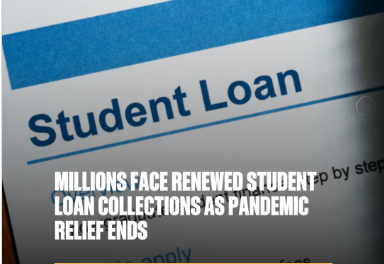The U.S. Department of Education has announced that federal student loan collections will resume on May 5, 2025, following a nearly five-year pause due to the COVID-19 pandemic. For millions of Americans, this significant change signals the end of a protracted period of relief. Officials estimate that the action will impact about 5 million borrowers who are already in default, and that figure could rise to about 10 million in the coming months.
Borrowers who don’t make their payments on time risk severe repercussions as part of the reopened collections process, such as harm to their credit ratings, wage garnishment, and the confiscation of their tax refunds. Social Security benefits may also be cut in certain circumstances, which would worry people who have fallen behind on their payments.
The start of collections marks a dramatic change from the Biden administration’s strategy, which concentrated more on offering borrowers support and alternatives, like the SAVE repayment plan. The Trump administration, on the other hand, is focused on collecting past-due debt, with the underlying belief that taxpayers shouldn’t be saddled with unpaid debt.
Summary of Changes in Student Loan Collection and Impact
| Key Change | Details |
|---|---|
| Resumption of Collections | Federal student loan collections restart on May 5, 2025, after a five-year pause due to COVID-19 relief measures. |
| Impact on Borrowers | 5 million borrowers in default, with numbers expected to rise to 10 million. |
| Consequences for Non-payment | Wage garnishments, tax refund seizures, and reductions in Social Security benefits are possible. |
| Impact on Credit Scores | Borrowers in default could see their credit scores drop by as much as 129 points. |
| Changes to Repayment Plans | Transition for many borrowers from the blocked SAVE plan to potentially higher monthly payments under new plans. |
| Staff Layoffs at Department of Education | Staff cuts have led to extended wait times and delayed assistance for borrowers navigating the collection process. |
| Loan Forgiveness Changes | The elimination of loan forgiveness provisions from certain repayment plans under the Trump administration. |
For more information on the current student loan situation, visit Department of Education.
The Return of Collections: A Significant Obstacle for Debtors
The U.S. government’s outstanding federal education debt exceeds an astounding $1.6 trillion, with more than 42 million Americans currently owed money on their student loans. Over 5 million people in this pool are currently in default, and things are only going to get worse. The extent of possible repercussions becomes even more evident as federal loan collections pick back up.
The U.S. Department of Education said that the highly enforced use of its authority, which includes seizing Social Security payments, paychecks, and tax refunds, will be part of the resumption of collection efforts. Millions of people may experience severe financial instability as a result, particularly since many borrowers have been covered by the relief period since 2020. Nonetheless, there are some objections to the policy change. Critics contend that this might make working-class families’ financial difficulties worse nationwide, particularly at a time when inflation and unemployment are still major issues.
For defaulted borrowers, the possibility of sharp drops in credit scores is a significant worry, in addition to the possibility of wage garnishments and seized benefits. According to VantageScore, borrowers who are in default may experience a 129-point decline in their credit scores. For many people attempting to regain their financial security and eventually pursue homeownership or other financial objectives, this presents a major challenge.
Modifications to Payment Schedules and the Stress on Debtors
The federal student loan system is going through a period of significant uncertainty at the same time that collections have resumed. The Biden administration’s SAVE repayment plan was viewed by many borrowers as an essential source of assistance. However, the plan was blocked in the summer of 2024 due to lawsuits led by the Republican Party, leaving borrowers who had already signed up in limbo. Now, these borrowers will have to make the tough choice of switching to a new repayment schedule, which might result in much higher monthly payments.
The Trump administration has also been instrumental in removing the forgiveness clause from some repayment plans, which has made things even more difficult for borrowers attempting to work their way through the system. Additionally, there is a backlog of borrowers seeking help as a result of recent staff layoffs at the U.S. Department of Education; some have reportedly been waiting up to eight hours to speak with a representative.
The frustration that many borrowers experience is only exacerbated by this lack of prompt assistance. The timing of these layoffs could not have been worse, according to higher education expert Mark Kantrowitz. Borrowers are left searching for answers because there is so much uncertainty surrounding repayment plans and collections.


